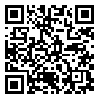Sat, Apr 12, 2025
[Archive]
Volume 17, Issue 4 (December 2021)
IJEEE 2021, 17(4): 1733-1733 |
Back to browse issues page
Download citation:
BibTeX | RIS | EndNote | Medlars | ProCite | Reference Manager | RefWorks
Send citation to:



BibTeX | RIS | EndNote | Medlars | ProCite | Reference Manager | RefWorks
Send citation to:
Ghotbi-Maleki M, Mohammadi Chabanloo R. New Computational Method for Optimal Allocation of Fault Current Limiters in Power Systems. IJEEE 2021; 17 (4) :1733-1733
URL: http://ijeee.iust.ac.ir/article-1-1733-en.html
URL: http://ijeee.iust.ac.ir/article-1-1733-en.html
Abstract: (3680 Views)
Expansion of power system causes short-circuit currents (SCC) of networks to exceed the tolerable SCCs of equipment. The utilization of fault current limiter (FCL) in such networks is needed to address this issue. This paper presents a new method for optimal allocation of FCLs to restrain the SCCs under permissible value. In this method, it is suggested to select a line as FCL location where the addition of FCL to this line will have the greatest impact on reducing the SCC of buses which their SCCs exceed the permissible value (known as exceeded buses). Since the optimization algorithms are not capable for optimal allocation of FCL especially in large networks, therefore, the proposed FCL allocation method is presented in the form of a computational process. In this computational process, the candidate lines for FCL location are firstly prioritized by a new index based on the effect of location of FCL on the reduction of SCCs. Then, the FCL size is determined by solving a quadratic equation firstly presented in this paper. The proposed method is implemented on networks with different sizes, and the obtained results show the performance of the proposed method over previous FCL allocation methods.
Keywords: Fault Current Limiter , Impedance Matrix of Network , Optimal Location , Optimal Size , Sensitivity Analysis , Short-Circuit Current
Full-Text [PDF 835 kb]
(1677 Downloads)
- A method for optimal allocation of FCLs to restrain the SCCs under permissible value;
- A computational process without the need to use optimization algorithms;
- Introducing an index, for determining the best location of FCL.
Type of Study: Research Paper |
Subject:
HVDC and FACTS
Received: 2019/11/25 | Revised: 2021/02/04 | Accepted: 2021/02/14
Received: 2019/11/25 | Revised: 2021/02/04 | Accepted: 2021/02/14
| Rights and permissions | |
 |
This work is licensed under a Creative Commons Attribution-NonCommercial 4.0 International License. |








